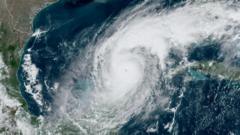NOAA has forecasted that the 2025 Atlantic hurricane season could be particularly busy, with the potential for between six to ten hurricanes forming this year, as the typical season sees around seven. This prediction stems from warmer sea temperatures linked to climate change, providing ample fuel for hurricane activity. Forecasters expect a total of 13 to 19 named tropical storms, including three to five major hurricanes that could reach category three or above, with sustained winds of over 111 mph.
Despite the increased forecast from last year’s historical season, scientists are sounding the alarm over the impact of recent budget cuts by the Trump administration, which have drastically reduced staffing within NOAA. These layoffs are feared to hinder efforts to monitor storms effectively, raising the stakes for communities vulnerable to hurricanes.
Warmer sea temperatures and neutral or weak La Niña patterns, which favor hurricane formation, are driving expectations for a more active season. However, as researchers at Colorado State University highlight, precise predictions depend on many variables, and forecasting with limited data resources could lead to significant complications.
Many experts express their concerns about understaffing leading to burnout among the remaining NOAA personnel, with key management positions left unfilled. Scientists warn that reduced operational capabilities may compromise essential storm tracking and warnings critical to public safety. Efforts to fill key vacancies have reportedly run into hiring bans, exacerbating the challenges faced by the National Weather Service in fulfilling its mandate.
The ramifications of NOAA's cuts extend beyond the U.S., according to climate experts who emphasize that the ability to accurately forecast weather is reliant on a robust understanding of global atmospheric conditions. While NOAA administrators maintain confidence in their team's capabilities, the ongoing situation poses a potential risk to effective hurricane forecasting, highlighting an urgent need for action to safeguard against future storms.
Despite the increased forecast from last year’s historical season, scientists are sounding the alarm over the impact of recent budget cuts by the Trump administration, which have drastically reduced staffing within NOAA. These layoffs are feared to hinder efforts to monitor storms effectively, raising the stakes for communities vulnerable to hurricanes.
Warmer sea temperatures and neutral or weak La Niña patterns, which favor hurricane formation, are driving expectations for a more active season. However, as researchers at Colorado State University highlight, precise predictions depend on many variables, and forecasting with limited data resources could lead to significant complications.
Many experts express their concerns about understaffing leading to burnout among the remaining NOAA personnel, with key management positions left unfilled. Scientists warn that reduced operational capabilities may compromise essential storm tracking and warnings critical to public safety. Efforts to fill key vacancies have reportedly run into hiring bans, exacerbating the challenges faced by the National Weather Service in fulfilling its mandate.
The ramifications of NOAA's cuts extend beyond the U.S., according to climate experts who emphasize that the ability to accurately forecast weather is reliant on a robust understanding of global atmospheric conditions. While NOAA administrators maintain confidence in their team's capabilities, the ongoing situation poses a potential risk to effective hurricane forecasting, highlighting an urgent need for action to safeguard against future storms.




















